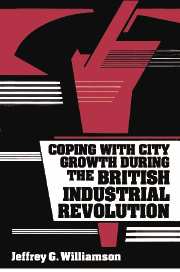Book contents
- Frontmatter
- Contents
- List of tables
- List of figures
- Acknowledgments
- 1 Coping with city growth, past and present
- 2 The urban demographic transition: Births, deaths, and immigration
- 3 Migrant selectivity, brain drain, and human capital transfers
- 4 The demand for labor and immigrant absorption off the farm
- 5 Absorbing the city immigrants
- 6 The impact of the Irish on British labor markets
- 7 Did British labor markets fail during the industrial revolution?
- 8 Did Britain's cities grow too fast?
- 9 City housing, density, disamenities, and death
- 10 Did Britain underinvest in its cities?
- References
- Index
9 - City housing, density, disamenities, and death
Published online by Cambridge University Press: 03 May 2010
- Frontmatter
- Contents
- List of tables
- List of figures
- Acknowledgments
- 1 Coping with city growth, past and present
- 2 The urban demographic transition: Births, deaths, and immigration
- 3 Migrant selectivity, brain drain, and human capital transfers
- 4 The demand for labor and immigrant absorption off the farm
- 5 Absorbing the city immigrants
- 6 The impact of the Irish on British labor markets
- 7 Did British labor markets fail during the industrial revolution?
- 8 Did Britain's cities grow too fast?
- 9 City housing, density, disamenities, and death
- 10 Did Britain underinvest in its cities?
- References
- Index
Summary
The perils of nineteenth-century city life
The quality of urban life has always played a key role in debates over the British industrial revolution. It certainly attracted the attention of Chadwick, Kay, and other social reformers in the 1830s and 1840s, but for hot rhetoric it is hard to beat Frederick Engels, who viewed the migration of rural labor to British cities as “social murder.” High density and resulting environmental decay both contributed to high city mortality and morbidity rates, and immigrants entered that environment at their peril. The early Victorian perception persists in academic debate even today, and the “pessimists” in the standard-of-living debate have made much of the issue. Although even the most ardent pessimist would acknowledge the dreary environment of rural England at this time, urban disamenities have, nonetheless, been viewed as seriously lowering working class living standards up to the 1840s and beyond. Not only was this true of old urban residents – whose cities, it was alleged, deteriorated in quality over time, but it was true of the new urban immigrants – who left more benign rural environments for employment in the ugly cities.
What did the common laborer forego by leaving some Sweet Auburn for some ugly urban Sheffield during the First Industrial Revolution? Are quantitative answers to such questions possible? A. J. Taylor (1975, p. liv) certainly didn't think so when surveying the standard-of-living debate more than a decade ago: “How … can a just comparison be made between [that] which removal from a rural to urban environment entailed, and the social amenities which town and factory, however squalid, offered …?”
- Type
- Chapter
- Information
- Coping with City Growth during the British Industrial Revolution , pp. 231 - 266Publisher: Cambridge University PressPrint publication year: 1990



